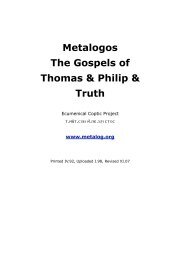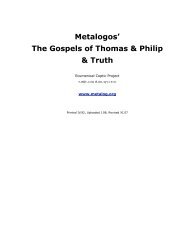Andrew Louth - Syriac Christian Church
Andrew Louth - Syriac Christian Church
Andrew Louth - Syriac Christian Church
Create successful ePaper yourself
Turn your PDF publications into a flip-book with our unique Google optimized e-Paper software.
28 INTRODUCTION<br />
an ineffable union’ (1045A). Maximus’ defence of two wills in the<br />
Incarnate Christ is not intended to suggest that there are two subjects<br />
in Christ, but to safeguard the full humanity in which the Second<br />
Person of the Godhead lives out a human life.<br />
A TRADITION OF COSMIC THEOLOGY: DENYS<br />
THE AREOPAGITE<br />
A final strand in Maximus’ theological heritage is more controversial.<br />
This is the influence on him of the works ascribed to Denys (or<br />
Dionysius) the Areopagite. These writings came to the notice of<br />
<strong>Christian</strong> thinkers barely fifty years before Maximus’ birth. They are<br />
first quoted (or misquoted) by the Cyrilline theologians who rejected<br />
Chalcedon (the ‘Acephaloi’ or Severan Monophysites) at the colloquy<br />
called by Justinian in his attempts to achieve a settlement of the<br />
Christological controversy in 532. They cited in their support a<br />
passage from one of the writings ascribed to the Areopagite where he<br />
refers to Christ’s ‘one theandric energy’—arguing that if it is<br />
legitimate to speak of one energy in Christ, it is legitimate to speak of<br />
a single nature. The Orthodox dismissed the authority of the<br />
‘Areopagite’, retorting that none of the Fathers—not Cyril, not<br />
Athanasius—had ever heard of him. But the compelling vision of the<br />
Areopagite was such that very soon his works were accepted by<br />
Monophysite and Orthodox alike as authentic: that is, as genuine<br />
works of that Denys, an Athenian who had been one of the judges of<br />
the Apostle Paul when he defended his preaching of <strong>Christian</strong>ity<br />
before the court of the Areopagus in about AD 52 (see Acts 17.22–34),<br />
and who, it was believed, had become one of the early bishops of<br />
Athens. In fact, it is now universally recognized that these works—the<br />
Celestial Hierarchy, theEcclesiastical Hierarchy, the Divine Names,<br />
the Mystical Theology, and some letters—were written at the end of<br />
the fifth, or beginning of the sixth, century, probably by a Syrian<br />
monk, who had conceived an enthusiasm for the brand of<br />
Neoplatonism we associate with the fifth-century ‘Platonic successor’<br />
(diadochus) at the Academy in Athens called Proclus (probably<br />
through having read some of their works, rather than having actually<br />
been a pupil at the Academy). 27 These works were edited in the<br />
middle of the sixth century by John, Bishop of Scythopolis in Palestine<br />
(modern Bet Shean), an orthodox Cyrilline Chalcedonian, and all the<br />
manuscripts of Denys that we have, except for the early <strong>Syriac</strong><br />
translation by Sergius of Reshaina, go back to John’s edition. 28 John<br />
was a man of enormous erudition: he provided a preface to the Corpus<br />
Areopagiticum and learned scholia to the individual works. Part of his<br />
purpose in this was to show that Denys really belonged to the




